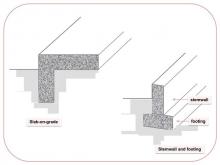 The foundations of a building are extremely important because they are the base upon which everything resides: they have to be strong and durable, resist movement and protect the home from moisture on and in the ground. It is therefore surprising that so little attention is paid to the foundations in much of modern home construction.
The foundations of a building are extremely important because they are the base upon which everything resides: they have to be strong and durable, resist movement and protect the home from moisture on and in the ground. It is therefore surprising that so little attention is paid to the foundations in much of modern home construction.
Traditional builds use either a "slab on grade" or "stemwall and footing" layout for the foundations. As you can see from the diagram, the former is a single, "monolithic" concrete pouring, with a large slab as the base of the building, edged by the foundation. The slab is covered in an appropriate material to form the floor and, in passive solar homes, represents a significant amount of usable thermal mass.
The latter option has a wide footing that is poured first, to spread the load of the building, upon which a second pouring of the stem wall is made. The wall is like a human leg, which transfers the building's weight down to the wide foot. In both approaches, the foundations are reinforced with steel rebar.
Foundation materials
Traditionally, foundations are made of concrete. However, there are alternatives. The most important of these is a material called "fly-ash concrete". Fly ash is a by-product of coal-fired power stations: it is produced in enormous quantities in most developed countries and is usually hauled away and buried in landfill because it is toxic. It is possible to use fly ash as a component in concrete, replacing between 15% and 30% of the Portland cement.
Fly-ash concrete offers two main benefits:
- It provides a productive use for toxic material that would otherwise be buried and left to seep into groundwater.
- It reduces the environmental impact of both concrete manufacture and coal-fired power supply by using an otherwise useless product and giving it a purpose.
You may be concerned by the potential health hazards of using a known toxic material in the foundations of your home – and rightly so! Rest assured that there is no evidence to suggest that the fly ash can escape its binding into fly-ash concrete. In fact, the US Government is so confident that there is no risk that it recommends the use of fly-ash concrete in all federal building projects.
Another alternative to the standard foundation is to use concrete blocks instead of pouring. In the same way as a traditional poured solution, the blocks are reinforced with steel rebar. They are laid on packed-down sub-soil and mortared in place with each successive course laid in a running bond for the best possible strength.
The main advantages of concrete block foundations are:
- They provide a space which can be filled with insulation material to improve heat retention in the otherwise extremely inefficient foundation.
- They can be made of fly-ash concrete to further reduce the environmental impact of home construction.
- You can use Faswall blocks, used in Europe for over 70 years, which mix waste wood material with the concrete. They are light and easy to work with.
- You can use Rastra blocks, which combine